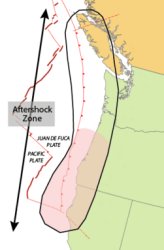
January Editorial
Slow Earthquakes

January Editorial
Slow Earthquakes
|
|
Every 14 months or so, residents of Vancouver Island in Canada, and in particular those living around the provincial capital of Victoria, will experience an earthquake - and not even notice that it is happening. This is not because the quakes are minor tremors - in fact the average magnitude is between 6 and 7 on the Richter scale, and earthquakes of this power have been known to kill thousands. What makes the Vancouver Island earthquakes different from regular earthquakes is not the magnitude, but the speed at which the earthquakes happen. These are so-called 'slow earthquakes'. Regular earthquakes streak along a fault at about 1.8 miles (3 kilometers) per second, and are over within a few minutes at most. A slow earthquake rambles along a fault line at a leisurely 4.3 mph (7 kph), and can be easily overtaken by a cyclist or even a not very energetic jogger. On the other hand a slow earthquake does have staying power and can travel around 100 miles (160 km) from start to finish, taking 10 days to 2 weeks for the journey. With seismologists fixated (reasonably enough) on the faster and much more destructive type of earthquake, no-one even noticed the existence of slow earthquakes until around a decade ago. Changes in seismographic record did pop up, but these were always regarded as a background oddity. The discovery that some of these oddities were actually slow earthquakes is credited to Dr Pascal Audet, an assistant professor in the Earth Sciences Department at the University of Ottawa. He is a leading author of a recent publication which explains how and why slow earthquakes are generated (ref). Although the phenomenon was first discovered on Vancouver Island in British Columbia, with Victoria at the epicenter, slow-motion quakes have since been detected at subduction zones offshore of Japan, New Zealand and the United States. The slow earthquakes in North America happen along the Cascadia subduction zone (also referred to as the Cascadia fault) which stretches from Vancouver Island in British Columbia to California. This is a long, sloping fault separating the Juan de Fuca and North America plates. Here, the denser oceanic plate is slowly subducting beneath the less dense continental plate offshore of BC, Washington State and Oregon. The North American Plate moves in a general southwest direction, overriding the oceanic plate, and the Cascadia Subduction Zone is where the overriding happens. One of the puzzling thing about slow earthquakes is how regular they are. Regular quakes are quite unpredictable, which is one reason why they are so dangerous, but slow quakes have a very steady pattern. They happen at set intervals, although the intervals differ depending on the area. For example, as already mentioned, Vancouver Island’s slow quakes happen every 14 months. But in Japan, slow quakes are as frequent as 6 months. In other cases, the intervals are even further apart - perhaps every two years. So recently Pascal Audet joined ranks with Roland Burgmann from Berkeley, California to see if they can figure out what causes the slow quakes. They looked at seismic data from slow earthquakes in Western Canada, Japan, Mexico, Costa Rica and New Zealand. They compared the frequency of slow earthquakes with other data about the structure and composition of the plates. It turns out there is a correlation between quake frequency and the level of quartz in the crust. Quartz is known to form when fluids in the Earth’s crust cool rapidly. Audet believes that when oceanic crust (which is full of fluids) is pushed down into the subduction zone it is exposed to increasing pressure and temperature. This pushes the fluids from the crust towards the surface - but the fault between the plates creates a seal which prevents the upward movement of the fluids. Pressure builds up underneath the fault and eventually pushes the plate down. Once the plate slips under, the fluid escapes the seal, cools down rapidly and crystallizes into quartz. The higher the level of fluids the more frequently pressure builds up, causing the fault to slip. This is what generates slow earthquakes. (ref) So is there any correlation between slow and regular quakes? For one, both types of quake happen along the same fault. But slow quakes happen some 35 to 55 km below the surface of the Earth, far deeper than regular earthquakes. At this depth there is more fluid and greater viscosity. This which allows the build-up of fluid pressure, but may also allow gentler plate movement. Regular earthquakes are also caused by a buildup of pressure, but this is solid pressure without the buildup of fluids underneath. Nevertheless, the scientists believe that the two types of earthquake are related. As Audet explains: "Every time there is a slow earthquake ..., it also puts a little bit more pressure on the part of the fault that produces the regular earthquakes … It puts the fault closer towards the next big earthquake." How much slow earthquakes influence the 'next big one' is still not certain; partly because of a lack of data. The instruments necessary to measure slow quakes have not been in place during major earthquakes, but Audet is working towards changing that. Journal Reference: |
| _______________________________ | ||||
| Home | | | Shopping | | | Database |
© Biscuit Software 2004-2015
All rights reserved